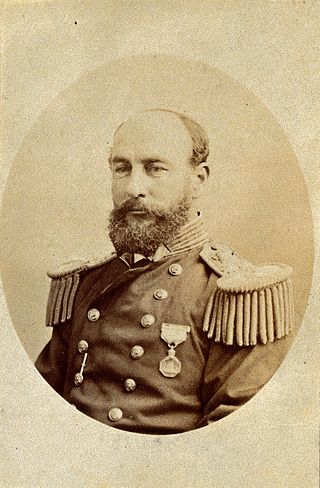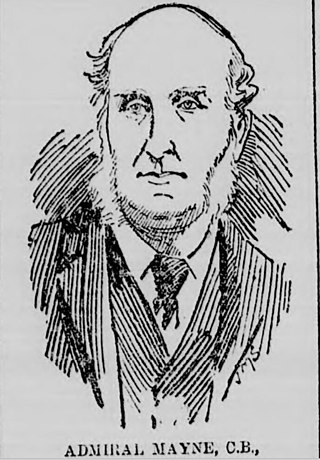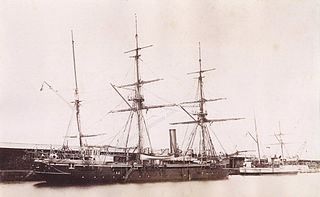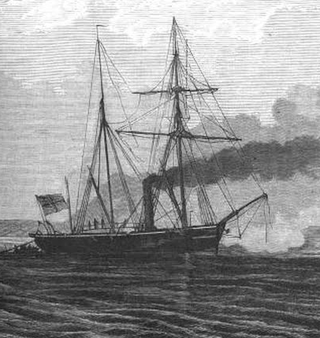
HMS Beagle was a Cherokee-class 10-gun brig-sloop of the Royal Navy, one of more than 100 ships of this class. The vessel, constructed at a cost of £7,803, was launched on 11 May 1820 from the Woolwich Dockyard on the River Thames. Later reports say the ship took part in celebrations of the coronation of King George IV of the United Kingdom, passing under the old London Bridge, and was the first rigged man-of-war afloat upriver of the bridge. There was no immediate need for Beagle, so she "lay in ordinary", moored afloat but without masts or rigging. She was then adapted as a survey barque and took part in three survey expeditions.

Vice-Admiral Sir George Strong Nares was a Royal Navy officer and Arctic explorer. He commanded the Challenger Expedition, and the British Arctic Expedition. He was highly thought of as a leader and scientific explorer. In later life he worked for the Board of Trade and as Acting Conservator of the River Mersey.

HMS Captain was a major warship built for the Royal Navy as a semi-private venture, following a dispute between the designer and the Admiralty. With wrought-iron armour, steam propulsion, and the main battery mounted in rotating armoured turrets, the ship was, at first appearance, quite innovative and formidable. However, poor design and design changes resulted in a vessel that was overweight and ultimately unstable. In terms of seaworthiness she was reported as closely comparable to the higher freeboard turret-ship HMS Monarch, but her reduced freeboard added a sense of "sluggishness". The Captain capsized in heavy seas, only five months after being commissioned, with the loss of nearly 500 lives.

HMS Challenger was a Pearl-class corvette of the Royal Navy launched on 13 February 1858 at the Woolwich Dockyard. She served the flagship of the Australia Station between 1866 and 1870.

HMS Tamar was the name for the British Royal Navy's base in Hong Kong from 1897 to 1997. It took its name from HMS Tamar, a ship that was used as the base until replaced by buildings ashore.

HMS Tamar was a Royal Navy troopship built by the Samuda Brothers at Cubitt Town, London, and launched in Britain in 1863. She served as a supply ship from 1897 to 1941, and gave her name to the shore station HMS Tamar in Hong Kong.

HMS Sulphur was a 10-gun Hecla-class bomb vessel of the British Royal Navy, famous as one of the ships in which Edward Belcher explored the Pacific coast of the Americas.

Vice Admiral Sir Henry Kellett, was an Irish naval officer and explorer.

Rear-Admiral Richard Charles Mayne was a Royal Navy officer and explorer, who in later life became a Conservative politician.

HMS Handy was a Handy-class destroyer which served with the Royal Navy. Built by Fairfield Shipbuilding and Engineering Company in 1895 she spent most of her time on the China Station, and was sold in Hong Kong during the Great War.

The Cruizer class was a class of six 17-gun wooden screw sloops built for the Royal Navy between 1852 and 1856.
Rear Admiral Sir Francis Augustus Collier, CB, KCH was a senior officer of the British Royal Navy during the early nineteenth century. Born into a naval family, Collier served in the French Revolutionary Wars and fought at the Battle of the Nile on Horatio Nelson's flagship. During the Napoleonic Wars he was engaged in campaigns in the West Indies and in 1819 he commanded an operation against pirates in the Persian Gulf. He remained in service for the next thirty years, holding several commands before his death in 1849 as commander of the China Squadron at Hong Kong.

HMS Rosario was an 11-gun Rosario-class screw sloop of the Royal Navy, launched in 1860 at Deptford Dockyard. She served two commissions, including eight years on the Australia Station during which she fought to reduce illegal kidnappings of South Sea Islanders for the Queensland labour market. She was decommissioned in 1875, finally being sold for breaking nine years later. A team from Rosario played the first ever New Zealand International Rugby Union match against a Wellington side in 1870. She was the fifth Royal Navy ship to bear the name, which was first used for the galleon Del Rosario, captured from the Spanish in 1588.
HMS Curlew (1812) was a Royal Navy Cruizer class brig-sloop built by (William) Good & Co., at Bridport and launched in 1812. She served with the Navy for only 10 years. During the War of 1812 she sailed from Halifax and captured several American privateers. Her greatest moment was her role in the 1819 British occupation of Ras Al Khaimah, leading to the signature of the General Maritime Treaty of 1820, which established the Trucial States, today the United Arab Emirates. Curlew was sold in 1822 in Bombay. She then had a 13 or so year career as an opium runner for James Matheson, one of the founders of the firm Jardine Matheson.

HMS Mullett was a Royal Navy 5-gun Philomel-class wooden screw gunvessel launched in 1860. She served on the coast of West Africa and on the North America and West Indies Station before being sold in 1872 at Hong Kong for mercantile use. As the sailing ship Formosa she sailed in the Far East before being converted to a magazine in Melbourne.

HMS Eclipse was a four-gun Cormorant-class first-class gunvessel launched in 1860 from the shipyard of J. Scott Russell & Co., Millwall. She served on the Australia Station, took part in the Second Taranaki War, including contributing men to a naval brigade which attacked the Maori stronghold at Gate Pā. The entire class were never satisfactory as gunvessels, partly due to their excessive draught, and Eclipse was broken up at Sheerness in 1867, only seven years after her launch.

HMS Rambler was an Algerine-class gunvessel of the Royal Navy, built by John Elder & Co., Glasgow and launched on 26 January 1880. She was commissioned as a survey vessel in 1884 and served in Chinese waters during the 1880s and 1890s. She provided men to a naval brigade during the Boer War and was sold on 23 January 1907. The work of this vessel is now remembered in Hong Kong by the Rambler Channel near Tsing Yi.

HMS Pelican was an 18-gun Cruizer-class brig-sloop of the Royal Navy, launched in August 1812. She is perhaps best known for her capture in August 1813 of the brig USS Argus. When the navy sold Pelican in 1865 she was the last Cruizer-class vessel still in service.

SMS Cyclop was a Camäleon-class gunboat of the Prussian Navy that was launched in 1860. A small vessel, armed with only three light guns, Cyclop served during the three wars of German unification; during the first, the Second Schleswig War on 1864, she guarded the Prussian coastline but saw no action. She supported the army's campaign against the Kingdom of Hanover during the Austro-Prussian War of 1866, and she defended the Elbe for the duration of the Franco-Prussian War of 1870–1871, but again took part in no battles. Badly deteriorated by 1872, she was stricken from the naval register in March that year and reconstructed into an iron-hulled gunboat. Recommissioned in 1875, she thereafter served abroad in the German colonial empire before being stricken again in 1888. She was thereafter used as a storage hulk before ultimately being broken up for scrap after 1914.

Foley Charles Prendergast Vereker was a Royal Navy Officer and hydrographic surveyor. He is particularly noted as an artist who produced navigational views and illustrations of the places he worked.


















